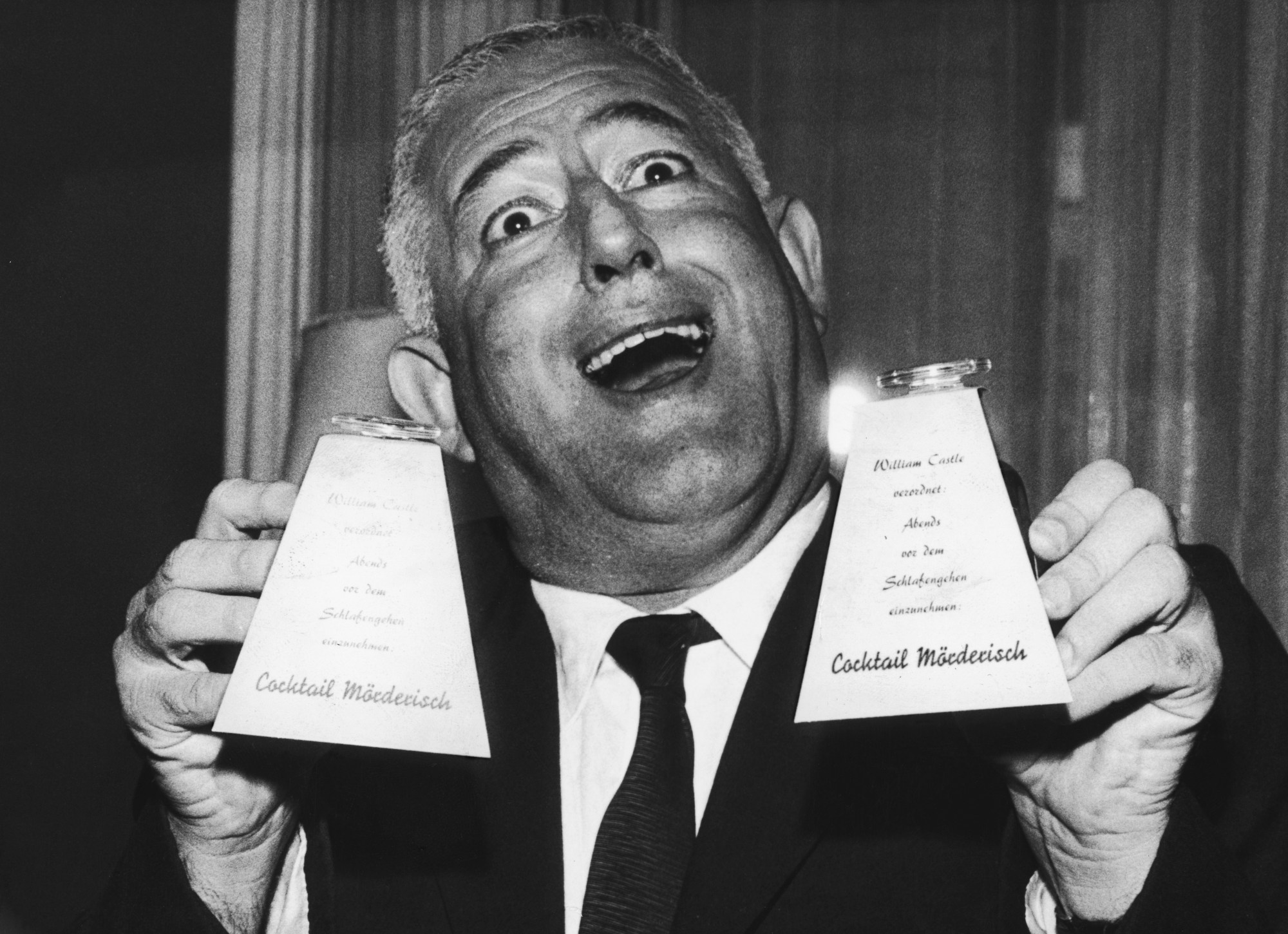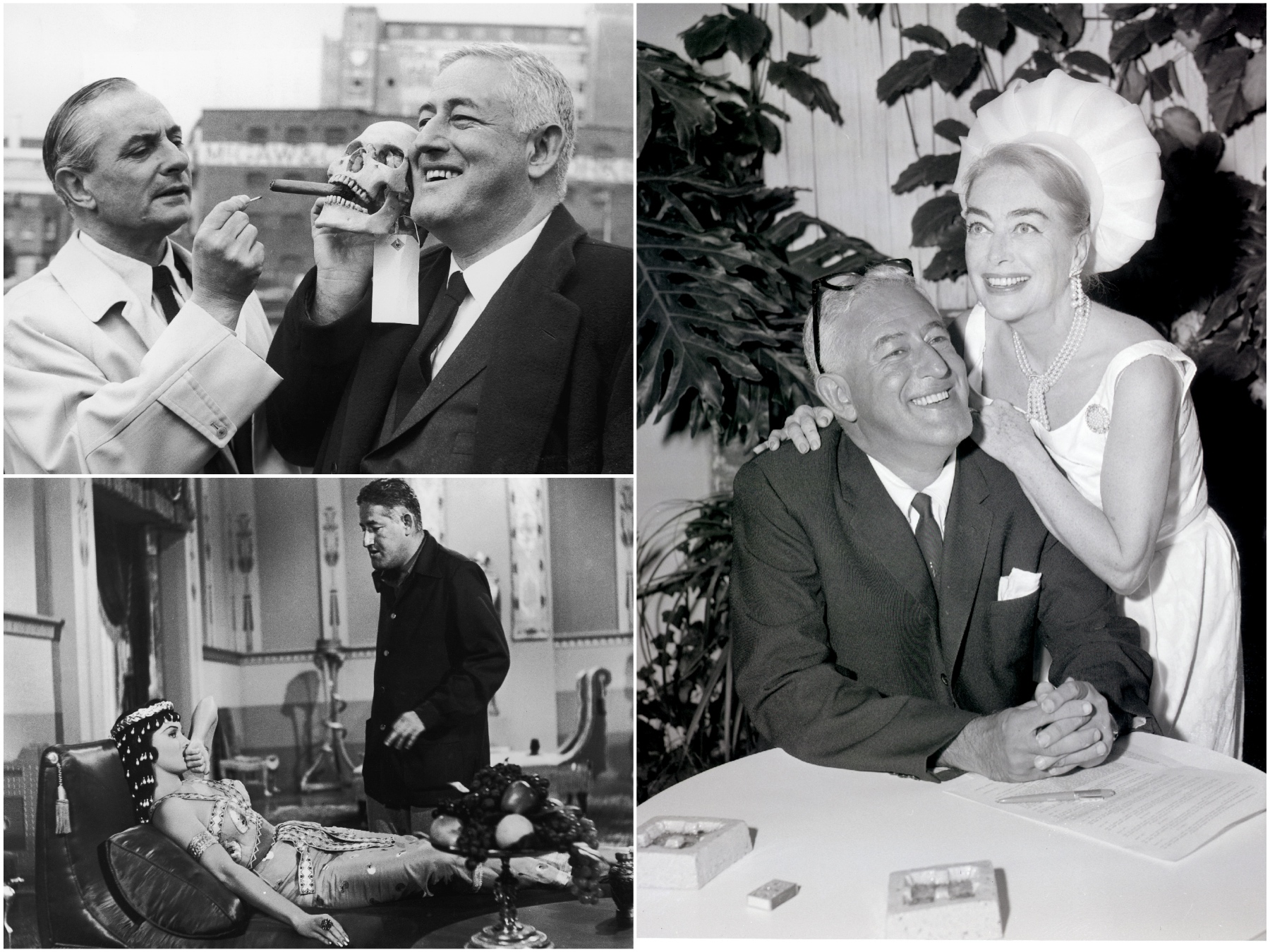
- Industry
Filmmakers’ Autobiographies: William Castle, Scaring America
Sixty years ago, American audiences willing to be scared could go to theaters to see Macabre, a horror movie advertised with great fanfare and an unusual warning: that viewers will be insured by Lloyd’s of London for one thousand dollars each, in case…they die of fright! It worked. The catchy gimmick was a new concept from the fertile and smartly mercantile mind of its director William Castle. One of the many publicity stunts that would become his trademark over a prolific career.
As he writes at the beginning of his 1976 autobiography, Step Right Up! I’m Gonna Scare the Pants Off America, published one year before his death: “It has always amazed and baffled me that audiences will wait patiently in line and pay money to have their wits scared out of them.” And once he found the recipe he made sure to milk it.
Born William Schloss Jr in 1914, orphaned at 11, he dropped out of school at 15 to become assistant to Bela Lugosi who was touring in the play Dracula. “I suggested a few new promotional gimmicks, he proudly recalls. A closed black coffin outside the theater and Oriental incense to get the audiences in the mood. And that Count Dracula would vanish on stage in a cloud of smoke, then suddenly reappear in the audience, snarling at the frightened spectators.” It made for great effects. He had found his calling and there would be no turning back for the ever-resourceful teenager who in his memoirs noted: “I began to learn firsthand the value of good publicity and showmanship.”
Fed up with everyone mispronouncing his surname, he converted it to its English translation (Schloss meaning Castle in German): a new name as a way of reinventing himself. His relentless drive for fame was fueled by an obsession that seems to have its roots in his childhood as he freely admits to “starving for recognition and applause” from an early age. We follow him to Hollywood where he arrived on September 30th, 1939, for his first foray in the dream factory at Columbia Studios under the auspices of the ruthless Harry Cohn, whom he describes as “the most dynamic, magnetic, frightening human being” he ever met.
There, starting in 1943, Castle would churn out dozens of very low budgets movies with titles like Just before Dawn, Conquest of Cochise (with Robert Stack), Slaves of Babylon, Drums of Tahiti (in 3D) The Americano (with Glenn Ford)… But after years of being a reliable journeyman, Castle wanted more, desperate to find a way to forge his own identity. He was relentless in trying to find original material. After reading If I Die Before I Wake, a novel by Sherwood King, he believed “it had the potential of a great motion picture: shocking, provocative, filled with suspense.” But Harry Cohn thought otherwise; not liking the fact the heroine was a murderess. He sent the treatment to Orson Welles who wanted to play the lead alongside Rita Hayworth, his wife at the time. He changed the title to The Lady From Shanghai and simply took over as director! Castle tells how disappointed he was, but swallowed his pride and agreed to work on the picture as an associate producer, knowing full well the marquee value of such glamorous headliners. A lot of filming took place at sea in Acapulco Bay in the winter of 1946, aboard the Zaca, Errol Flynn’s yacht, rented for the occasion. Castle consigned it all to a diary from which he quotes a few entries, offering great insights on how the one he called the “insomniac boy genius” would work, his eccentricities, the rising budget, and the magic of the ever-evolving creative process… And a last bittersweet comment. “The Lady from Shanghai was a box-office failure. Today it is a masterpiece.”
His recollections then flash forward. After the unexpected success of Macabre in 1958, Castle is keen to continue in this vein. “I had always recognized the power of showmanship. Now I had proof it was pure gold and I was determined to mine it over and over again.” A year later, for the release of his next feature The House on Haunted Hill starring Vincent Price in one of his many iconic roles, he needed another promotional gimmick. It would be the “Emergo”, a plastic skeleton rigged on a wire flying above the audiences’ heads in the theaters. Screams guaranteed…How could he possibly top that? With his follow up The Tingler, again staring Price, this time as a mad scientist, unsuspecting audiences would be jolted at crucial moments of the film by a vibrating device placed under their seats! The idea of what he would call the “Percepto” (!), came to Castle while replacing a bulb in his kitchen. “I got a helluva shock and suddenly I had my gimmick. In the final count, I think we must have buzzed 20,000,000 behinds.” Quite an achievement indeed for the self-proclaimed N°1 Shock expert.

(top left) With James Carreras, the founder of Hammer Films ,at Waterloo Station, London, 17th April 1962. Castle was in Britain to direct The Old Dark House, which he co-produced with Hammer Films. (bottom, left) With Rhonda Fleming as Cleopatra on the set of Serpent of the Nile, 1953. (right) In September of 1964, Joan Crawford in Castle’s Hollywood office to sign a contract for a new movie, I Saw What You Did.
moviepix/bettman/hulton archives/getty images
Many more colorful anecdotes abound in Step Right Up… How, after seeing Psycho in 1960, he sought for his new movie Homicidal, the story of a transvestite killer, a better gimmick than Hitchcock and his famous injunction that no one was allowed into the theater once the picture began. He came up with a “Fright break”! “Two minutes before the end, the audience could hear my recorded voice saying that they had sixty-five seconds to allow anyone too frightened to see the end of the picture could leave the theater and get a full admission refunded.” Theater owners were not so happy.
How he convinced Joan Crawford to appear in Straight-Jacket as an ax-wielding crazed killer and to be part of the promotional tour where audiences were given little cardboard axes as souvenirs. His only regret: that a tie-in with the Gillette Razor Company could not be worked out! Imagine the bloody cutting-edge potential….
How he got to read Ira Levin’s Rosemary’s Baby in galley form (his agent confessed he was the second to do so after Alfred Hitchcock,) and how, instantly hooked, he optioned the rights hoping Paramount would produce and let him direct the film adaptation. But the studio and Robert Evans, in charge of production, had Roman Polanski in mind for the job and again he has to settle for a producer credit. At first weary, Castle admits he liked Polanski even though there were some disagreements on the casting: Robert Redford and Tuesday Weld were first choices for the couple before Mia Farrow and John Cassavetes. In his memoirs, Castle compares the Rosemary’s Baby experience as “Heaven, Purgatory, and Hell”!
Castle will direct one last horror flick in 1973, Shanks with French mime star Marcel Marceau (who had initially wanted Polanski behind the camera) in a speaking part and without his trademark white make up as a man able to manipulate dead bodies like a puppeteer. A total misfire. A year later Castle has his last producer credit on Bug, directed by Jeannot Szwarc, for which he tried one more time the recipe that made his fame and fortune. Insuring his star performer, “Hercules” the cockroach (!) with a one million dollar policy before embarking on promotional tour and personal appearances. Happily confessing: “I was back in my element.”
Inspired by P.T. Barnum, William Castle with his flair for mad inventiveness and sheer audacity, was definitely one of the most outlandish films promoter/producer/director of all time. “One of the great Hollywood’s characters” as Vincent Price would comment. A fame grifter who made public relations an art form and turned himself into his own biggest star. No wonder he was an inspiration to John Waters who religiously declared: “William Castle was God!” Sadly, they don’t make them like him anymore….

